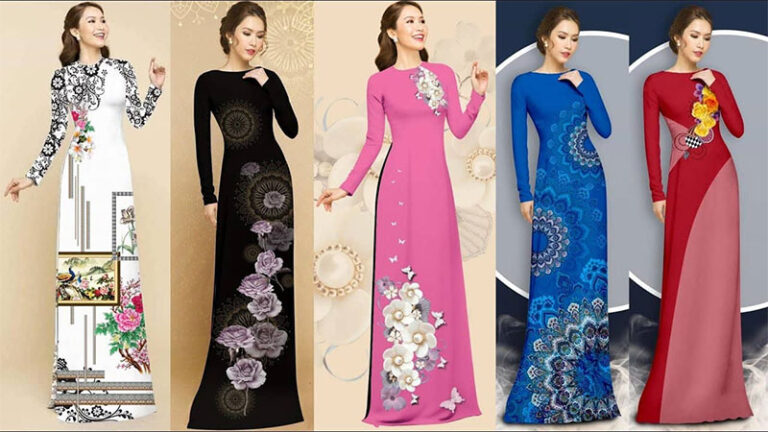
Here’s an overview:
- Introduction to Vietnamese Traditional Clothing
- The history and significance of ao dai
- The diversity of traditional Vietnamese garments
- The craftsmanship and materials of Vietnamese traditional clothing
- The contemporary influence of Vietnamese traditional clothing
- The symbolism and cultural significance of traditional clothing in Vietnamese society
- The regional variations in Vietnamese traditional clothing
- The role of traditional clothing in Vietnamese festivals and ceremonies
- The modern adaptation and evolution of Vietnamese traditional clothing
- The Future of Vietnamese Traditional Clothing
Contents
- 1 Introduction to Vietnamese Traditional Clothing
- 2 The history and significance of ao dai
- 3 The diversity of traditional Vietnamese garments
- 4 The craftsmanship and materials of Vietnamese traditional clothing
- 5 The contemporary influence of Vietnamese traditional clothing
- 6 The symbolism and cultural significance of traditional clothing in Vietnamese society
- 7 The regional variations in Vietnamese traditional clothing
- 8 The role of traditional clothing in Vietnamese festivals and ceremonies
- 9 The modern adaptation and evolution of Vietnamese traditional clothing
- 10 The Future of Vietnamese Traditional Clothing
Introduction to Vietnamese Traditional Clothing
Vietnam is a multi-ethnic country. Each ethnic group has different customs and costumes, creating a colorful picture of traditional costumes. Vietnamese traditional clothing reflects the Vietnamese people’s diverse cultural heritage and rich history. It is known for its elegance, intricate designs, and vibrant colors and holds a special place in the country’s cultural identity. Through centuries of history, with cultural interference, designers are incorporating traditional fabrics and patterns into modern fashion, creating a fusion of past and present.
Current Vietnamese traditional costumes are divided into the following categories: Ao Dai, Ao Tu Than, Ao Ba Ba, Ao Cham…
Key Features of Vietnamese Traditional Clothing:
- Ao Dai: The most iconic Vietnamese garment, the Ao Dai is a form-fitting tunic worn over trousers. It is often worn at weddings, festivals, and ceremonies.
- Ao Tu Than: “Ao Tu Than” translates to “four-part dress” or “four-panel traditional dress” in English. This traditional Vietnamese dress is typically worn by women and is characterized by its four panels that are stitched together. It is often associated with traditional and formal occasions.
- Ao Ba Ba: “Ao Ba Ba” is a traditional Vietnamese outfit typically worn by women in southern Vietnam. It comprises a loose-fitting, short-sleeved shirt paired with wide-legged trousers or a skirt. The shirt often has a square neckline and is designed to be comfortable, especially in southern Vietnam’s hot and humid climate.
- Non La: The traditional conical hat, Non La, symbolizes Vietnamese rice farmers and protects them from the sun and rain.
- Ao Yem and Quan Ho: Traditionally worn by Vietnamese women, the Ao Yem is a fitted blouse, and the Quan Ho are wide-legged pants. Together, they form a graceful and modest attire.
- Turban (Khan Dong): Worn by men and women, the turban symbolizes wisdom, honor, and tradition in Vietnamese culture.
- Brocade (Lanh My A): Intricately woven fabrics made using traditional techniques, brocade is often used in ceremonial clothing to display wealth and status.
Significance of Vietnamese Traditional Clothing:
Vietnamese traditional clothing not only serves as a form of cultural expression but also plays a significant role in showcasing the craftsmanship and artistry of Vietnamese artisans. Each garment carries historical symbolism and reflects the values and beliefs of the Vietnamese people.
Modern Influences on Vietnamese Traditional Clothing:
While traditional clothing remains integral to Vietnamese culture, modern influences have led to innovative designs that blend traditional elements with contemporary styles. Designers incorporate traditional fabrics and motifs into modern fashion, creating a fusion of past and present.
Preservation of Tradition:
Efforts are being made to preserve and promote Vietnamese traditional clothing, ensuring that future generations continue to appreciate and celebrate the beauty and significance of these timeless garments. Through cultural events, fashion shows, and educational programs, Vietnamese traditional clothing continues to thrive and evolve in the modern world.
The history and significance of ao dai
In fact, up to now, it is still being determined where exactly the origin of the Vietnamese ao dai began. Still, based on the heroic historical context of thousands of years, researchers have concluded that this national costume appeared in the period 38 – 42 AD. The first people to wear this outfit were Vietnam’s first two female generals – Hai Ba Trung, during the resistance war against the Han army. To have a long dress with bold cultural characteristics, this outfit has had to go through many different stages of variation. Initially worn by men and women, it evolved into an elegant garment primarily worn by Vietnamese women today. The Ao Dai typically consists of a long tunic with side slits worn over wide-legged pants. Its design reflects the graceful and modest attributes valued in Vietnamese culture.
In Vietnamese history, the Ao Dai symbolizes national pride and identity. During the French colonial period, women started to wear the Ao Dai as a symbol of resistance and solidarity. Its popularity surged in the 1950s and 1960s, when it became a symbol of liberation and empowerment for Vietnamese women.
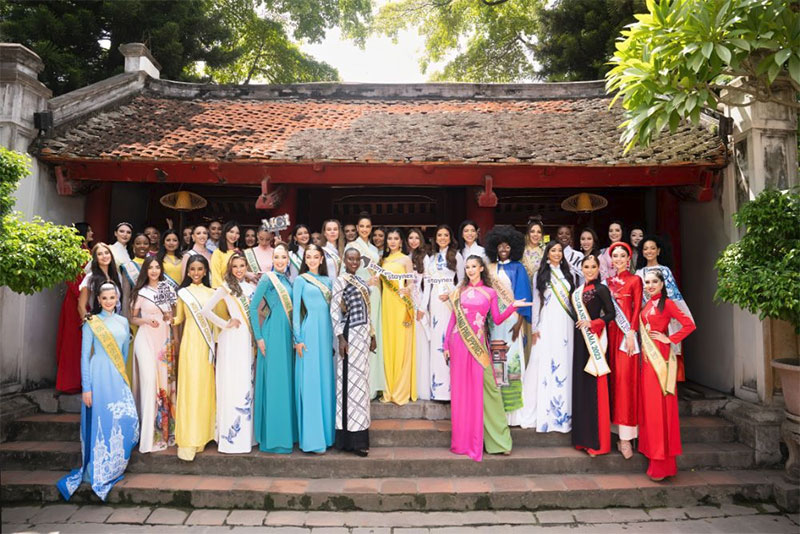
The Ao Dai is a symbol of national pride and an embodiment of Vietnamese cultural heritage. Its intricate designs and vibrant colors often incorporate motifs inspired by Vietnamese landscapes, flora, and fauna. The garment’s elegance and gracefulness make it popular for special occasions such as weddings, festivals, and cultural events.
The significance of the Ao Dai extends beyond its aesthetics; it represents tradition, values, and the resilience of the Vietnamese people. As a cultural symbol, the Ao Dai continues to be celebrated and preserved, showcasing the beauty and sophistication of Vietnamese traditional clothing to the world.
In 1970, the Vietnamese ao dai won a gold medal at the Osaka International Fair, Japan, and was honored as one of the most beautiful costumes.
The diversity of traditional Vietnamese garments
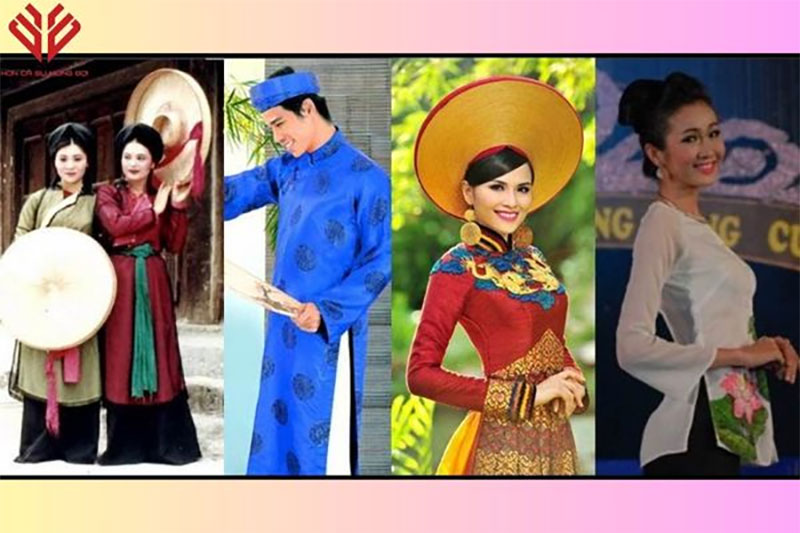
- The diversity of traditional Vietnamese garments reflects the country’s rich cultural heritage.
- Ao Dai, the national costume of Vietnam, symbolizes elegance and grace. It consists of a long tunic top worn over trousers and is traditionally worn on special occasions such as weddings and Tet (Lunar New Year).
- The Ao Ba Ba, a traditional outfit from the southern region of Vietnam, is a loose-fitting tunic paired with wide-legged pants. Farmers and laborers commonly wear it for its comfort and practicality.
- For festive celebrations, women often don the colorful and intricate Brocade dresses handwoven by ethnic minority groups in Vietnam’s mountainous regions. These garments feature elaborate patterns and vibrant hues that showcase the skill and artistry of the weavers.
- The ethnic diversity in Vietnam is also reflected in the diverse range of traditional headwear, from the Non La (conical hat) worn by farmers to the turban-like headscarves worn by ethnic minorities in the highlands.
- Each region in Vietnam boasts unique traditional garments influenced by local customs, climate, and landscapes. From the royal elegance of the Nguyen Dynasty’s royal costumes to the practicality of the everyday attire of fishermen in coastal regions, Vietnamese traditional clothing offers a glimpse into the country’s multifaceted identity.
The craftsmanship and materials of Vietnamese traditional clothing
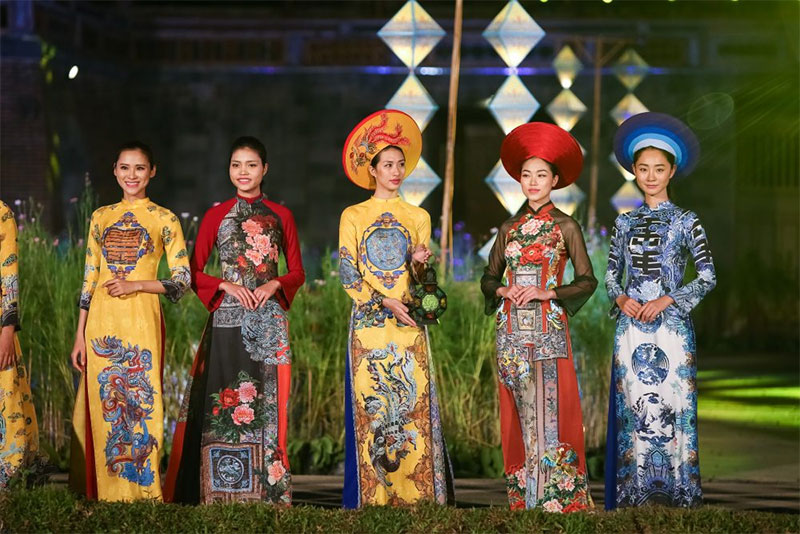
Vietnamese traditional clothing, reflecting the country’s rich cultural heritage, varies across regions and ethnic groups. The craftsmanship and materials used in traditional Vietnamese clothing showcase a blend of historical influences and local resources. Here are some common elements:
- Vietnamese traditional clothing, Ao Dai, showcases exquisite craftsmanship and meticulous attention to detail.
- Artisans employ traditional techniques such as hand embroidery, appliqué, and fabric dyeing to create intricate designs on the Ao Dai.
- The materials used in Vietnamese traditional clothing are carefully selected for their quality and symbolism. For example, silk is often chosen for its luxurious feel and cultural significance.
- Silk is believed to bring good fortune and prosperity to Vietnamese culture, making it a popular choice for special occasions and ceremonies.
- In addition to silk, other materials like cotton and satin are also used in producing Ao Dai, each offering unique textures and qualities.
- The combination of fine craftsmanship and high-quality materials results in garments that are visually stunning and comfortable to wear.
- Traditional clothing like the Ao Dai reflects the rich cultural heritage of Vietnam and the skill of its artisans in preserving and showcasing traditional techniques.
The contemporary influence of Vietnamese traditional clothing
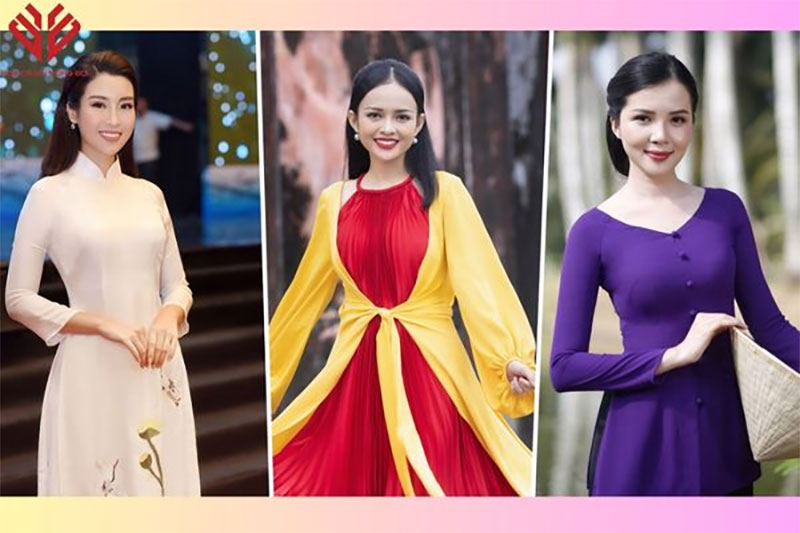
Vietnamese traditional clothing continues to impact contemporary fashion, culture, and identity significantly. Here are some ways in which traditional clothing influences stylish Vietnamese fashion and lifestyle:
- Vietnamese traditional clothing has a rich history that inspires contemporary fashion designers and influencers worldwide.
- Designers often incorporate elements of traditional Vietnamese attire, such as Ao Dai, into modern clothing pieces, creating a fusion of old and new styles.
- The elegant silhouette and intricate detailing of traditional Vietnamese clothing have made it popular for special occasions and red-carpet events.
- Vietnamese fashion shows and designers have gained international recognition for their innovative interpretations of traditional clothing, showcasing the beauty and versatility of these garments.
- Influencers and celebrities often wear modern adaptations of traditional Vietnamese clothing on social media platforms, further popularizing these styles.
- Using sustainable fabrics and practices in creating traditional Vietnamese clothing has also influenced the global fashion industry, promoting eco-friendly fashion choices.
- International fashion houses have drawn inspiration from Vietnamese traditional clothing, incorporating elements like delicate embroidery and flowing fabrics into their collections.
- The enduring appeal of Vietnamese traditional clothing lies in its timeless elegance and cultural significance, making it a beloved symbol of Vietnamese heritage in the modern world.
The symbolism and cultural significance of traditional clothing in Vietnamese society
In Vietnamese culture, traditional clothing holds deep symbolism and cultural significance, reflecting the country’s rich heritage and history. These garments are not merely worn for aesthetic purposes but carry a wealth of meaning embedded in the intricate designs and colors.
- Ao Dai: The iconic Ao Dai, a long tunic worn over loose-fitting pants, symbolizes elegance, modesty, and grace in Vietnamese society. It is often worn on special occasions like weddings, Tet (Lunar New Year), and important ceremonies, representing tradition and cultural pride.
- Colors: The colors of traditional Vietnamese clothing are carefully chosen based on cultural beliefs. For example, red symbolizes good fortune and joy, while yellow represents royalty and prosperity. By wearing specific colors, individuals convey messages about their values and aspirations.
- Embroidery and Patterns: Intricate embroidery and patterns on traditional clothing often tell stories of Vietnamese folklore, legends, and traditions. These embellishments are not just decorative but serve as a form of artistic expression and preservation of cultural heritage.
- Regional Variations: Different regions in Vietnam have distinct traditional clothing styles, reflecting unique local customs and identities. For instance, the Ao Tu Than in Northern Vietnam differs from the Ao Ba Ba in Southern Vietnam, showcasing diversity within Vietnamese culture.
- Preservation of Tradition: By wearing traditional clothing, Vietnamese people honor their ancestors and heritage, fostering a connection to the past. In a rapidly modernizing world, donning these garments becomes a way to preserve and pass cultural traditions to future generations.
Traditional clothing in Vietnamese society transcends mere apparel; it symbolizes identity, history, and cultural pride, encapsulating the essence of a nation rich in tradition and heritage.
The regional variations in Vietnamese traditional clothing
Vietnamese traditional clothing exhibits diverse regional variations, with different styles, materials, and designs reflecting the cultural diversity across the country. The variations are often influenced by geography, climate, and the distinct traditions of various ethnic groups. Here are some examples of regional variations in Vietnamese traditional clothing:
- Northern Vietnam:
- Ao Dai: In Northern Vietnam, the Ao Dai is typically more conservative, with high collars and long sleeves. The fabric used is often thicker to withstand the colder climate of the region.
- Central Vietnam:
- Ao Dai: In Central Vietnam, the Ao Dai is characterized by bolder colors and patterns. The silhouette may also be more form-fitting compared to other regions. Additionally, women may pair their Ao Dai with a Non La (conical hat) for a traditional touch.
- Southern Vietnam:
- Ao Ba Ba: In Southern Vietnam, the traditional clothing for women is the Ao Ba Ba, a loose-fitting top paired with wide-leg pants. The fabric is usually lightweight and comfortable, suited for the hot and humid climate of the region.
- Ethnic minority groups:
- Each ethnic minority in Vietnam has its unique traditional attire, often reflecting its cultural heritage and way of life. For example, the Hmong people in the mountainous regions of Northern Vietnam are known for their intricately embroidered clothing in vibrant colors.
- Influence of modern trends:
- With The modernization and influence of Western fashion, traditional Vietnamese clothing styles have blended with contemporary designs. This fusion is especially evident in urban areas where young people may incorporate elements of traditional attire into modern outfits.
- Importance of regional variations:
- The regional variations in Vietnamese traditional clothing not only showcase the diversity of the country’s culture but also serve as a means of preserving and celebrating unique heritage. Understanding and appreciating these differences can give one a deeper insight into Vietnam’s rich sartorial traditions.
The role of traditional clothing in Vietnamese festivals and ceremonies
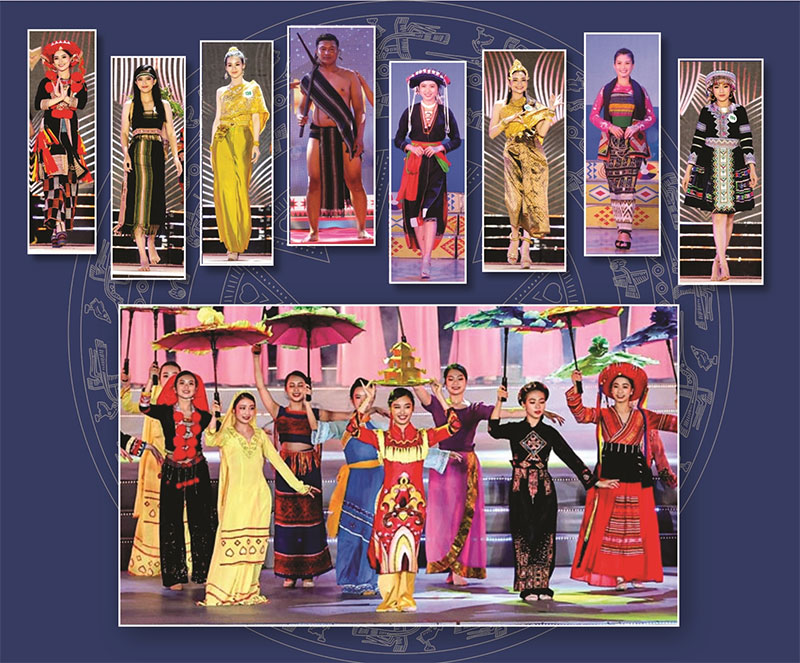
Traditional clothing plays a significant role in Vietnamese festivals and ceremonies, reflecting the country’s rich cultural heritage and traditions. Here are some key points highlighting the importance of traditional clothing on these occasions:
- Symbolism: Traditional Vietnamese clothing, such as the Ao Dai, is often adorned with intricate patterns and vibrant colors with symbolic meanings. These symbols can represent aspects of nature, mythology, or historical events, adding depth and significance to the attire worn during festivals and ceremonies.
- Cultural Identity: Wearing traditional clothing during festivals and ceremonies helps to preserve and celebrate Vietnam’s cultural identity. It serves as a visual representation of the country’s customs, values, and traditions, reinforcing a sense of pride and unity among the people.
- Social Hierarchy: Traditional outfits signify social hierarchy and status in many Vietnamese ceremonies. For example, specific garments may be reserved for royalty, religious leaders, or elders, emphasizing respect and hierarchy within the community.
- Rituals and Customs: Traditional clothing is often intricately linked to specific traditions and customs performed during festivals and ceremonies. The attire worn may vary depending on the occasion’s significance, with particular garments designed for auspicious events such as weddings or lunar New Year celebrations.
- Historical Significance: The evolution of traditional Vietnamese clothing reflects the country’s history and influences from various dynasties and cultures. By donning traditional attire during festivals and ceremonies, individuals pay homage to their roots and the legacy of their ancestors.
In conclusion, traditional clothing is unique in Vietnamese festivals and ceremonies, serving as a vital link to the past and a cherished part of the country’s cultural tapestry.
The modern adaptation and evolution of Vietnamese traditional clothing
The modern adaptation and evolution of Vietnamese traditional clothing reflect a dynamic interplay between cultural heritage and contemporary fashion trends. Various factors, including globalization, urbanization, and changing lifestyles, have influenced how traditional clothing is perceived, designed, and worn in modern Vietnam. Here are some aspects of the contemporary adaptation and evolution of Vietnamese traditional clothing:
- Traditional Vietnamese clothing has experienced a modern adaptation in recent years, blending elements of tradition with contemporary style.
- Designers have been incorporating traditional Vietnamese patterns, colors, and fabrics into modern silhouettes, creating a fusion of the old and the new.
- This evolution has allowed for greater versatility in how traditional clothing is worn, making it more accessible and appealing to a broader audience.
- Using innovative materials and techniques has also contributed to modernizing Vietnamese traditional clothing, ensuring comfort and durability.
- Vietnamese designers have been experimenting with different cuts, styles, and embellishments, adding a fresh twist to classic garments.
- Incorporating traditional motifs such as lotus flowers, dragons, and bamboo has helped maintain the cultural significance of Vietnamese clothing.
- These modern adaptations have preserved the essence of Vietnamese traditional clothing and breathed new life into age-old traditions.
- The evolution of traditional Vietnamese clothing reflects the dynamic nature of fashion, showing how heritage can be reimagined and celebrated innovatively.
- By embracing tradition and modernity, Vietnamese traditional clothing continues to captivate and inspire fashion enthusiasts worldwide.
The Future of Vietnamese Traditional Clothing
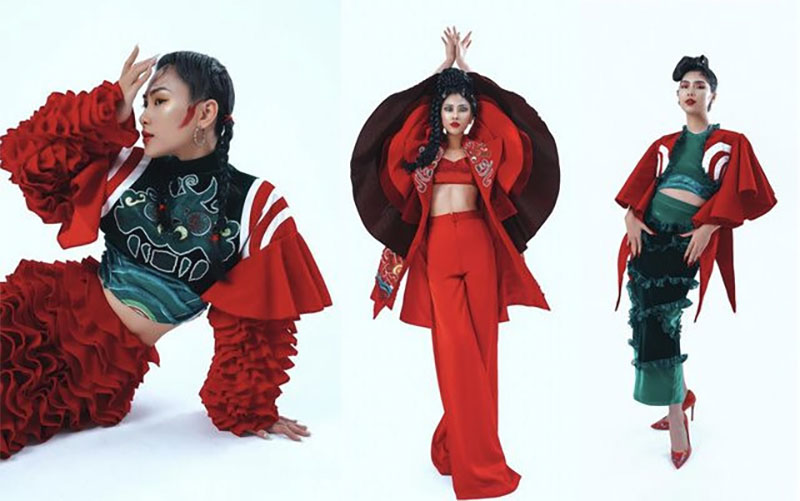
The future of Vietnamese traditional clothing is likely to be shaped by a combination of cultural preservation, innovation, sustainability, and changing societal trends. Here are some potential aspects that may influence the future of Vietnamese traditional clothing:
- Vietnamese traditional clothing is deeply rooted in history and culture, blending traditional aesthetics with modern influences.
- Designers are incorporating traditional elements into modern fashion, creating a fusion of old and new styles.
- Innovative techniques, such as using sustainable materials and modern technology, are being applied to revive and preserve Vietnamese traditional clothing.
- The younger generation is showing a renewed interest in wearing traditional clothing, leading to a resurgence in popularity.
- International recognition and collaborations are helping to promote Vietnamese traditional clothing on a global scale.
- Fashion shows, events, and cultural festivals showcase the beauty and diversity of Vietnamese traditional clothing, attracting wider audiences.
- As Vietnamese traditional clothing continues to evolve and adapt to contemporary tastes, it remains an integral part of Vietnamese identity and heritage.
This website page is unbelievable. The radiant substance reveals the moderator’s excitement. I’m awestruck and expect additional such astounding posts.